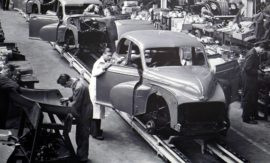Intended learning outcomes: Explain the template for bill of material and routing sheet used to work out similar variants.
The lower the value added to the order, the lower the effort that should be expended on customer-specific adaptations. Hence the term “Basic” engineer-to-order for these archetypes, where engineering complexity needs to be kept to a minimum. Cable cars and asphalt mixers are good examples of this. On the one hand, cable car operators expect a cable car design that is specific to their ski area. On the other hand, the equipment as a whole regularly has to be adapted to the topographical conditions. Typical reasons for customer-specific adaptations to asphalt mixers are regional environmental standards, or harsh climatic conditions. Examples where even less engineer-to-order can be carried out for each order would include fastening tools or air diffusion grilles. But customers often order an entire lot of items that are specifically adapted for a particular construction project.
In order to reduce the engineering complexity, a medium degree of standardization and automation is recommended here. However, the low order repeat rate is a limitation. Standardization is primarily based on commonality of components and a modular product concept. Building on that, a product family is often developed for the production environment on a make-to-order basis and a mass customization production type. If the product and process configurator cannot completely specify the customer order, the provisional configuration result is adapted using adaptive techniques, where the bill-of-material positions and operations can be added, amended, or deleted.
A limited degree of automation is determined by the definition of product families with an unfinished product structure, and the development can then be finalized according to customer requirements. Figure 7.4.2.1 illustrates the technique.
Fig. 7.4.2.1 Template for bill of material and routing sheet used to work out similar variants.
The unfinished product structure looks like a template for a product structure. It contains materials that a company (e.g., a sheet metal working firm) typically uses as a starting point for a product (e.g., various aluminium or steel sheets), and a sequence of loosely described operations in which the firm has recognized expertise (e.g., cutting, bending, assembly) or that they get done by external suppliers (e.g., surface treatment). Components or operations may also be entered as dummy positions. The customer’s order parameters are used by the configurator as much as possible to decide the positions that have to be part of the order. The configurator stops wherever in the template a “?,” i.e., the symbol for an information gap, is encountered and asks for entry of the attribute value specific to the current customer order, e.g., the quantity per for the components C1, C2,…, Cn. The result, although intermediate, is often already useful for initial cost calculations (for example, where +/- 10% accuracy is sufficient) and for logistical control during order execution. The intermediate result is then updated as necessary using adaptive techniques, according to the data from the customer, by adding, changing, and removing bill of material and routing positions.
This technique allows a certain degree of automation, as the same unfinished product structure can be used for many customer orders. In practice, it has been observed that automation in “Basic” engineer-to-order is primarily achieved through the use of product configurators in the tendering process.
Routing sheet
Course section 7.4: Subsections and their intended learning outcomes

7.4 Generative and Adaptive Techniques for Engineer-to-Order (ETO)
Intended learning outcomes: Differentiate between the classical procedure and different archetypes of engineer-to-order. Describe the approach for basic and for repeatable engineer-to-order.

7.4.1 Classical Procedure and Different Archetypes of Engineer-to-Order (ETO)
Intended learning outcomes: Explain different archetypes in engineer-to-order: basic, repeatable, complex, non-competitive ETO.

7.4.2 Approach for Basic Engineer-to-Order
Intended learning outcomes: Explain the template for bill of material and routing sheet used to work out similar variants.

7.4.3 Approach for Repeatable Engineer-to-Order
Intended learning outcomes: Describe a typical engineer-to-order business process and its permanent enabling process. Explain role of the permanent engineer-to-order enabling process.
